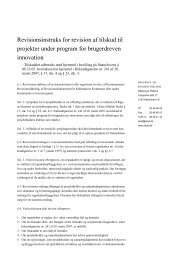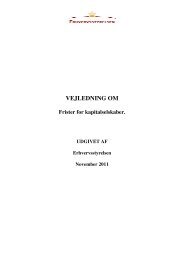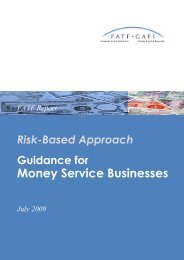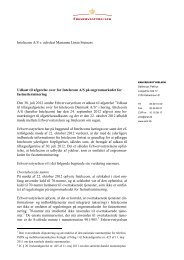Competing in the Single Market - SMEs and ... - Erhvervsstyrelsen
Competing in the Single Market - SMEs and ... - Erhvervsstyrelsen
Competing in the Single Market - SMEs and ... - Erhvervsstyrelsen
Create successful ePaper yourself
Turn your PDF publications into a flip-book with our unique Google optimized e-Paper software.
<strong>SMEs</strong> <strong>and</strong> Innovation<strong>SMEs</strong> as Drivers of Innovation <strong>and</strong> Competitiveness <strong>in</strong> <strong>the</strong> B4Some of <strong>the</strong> challenges <strong>and</strong> opportunities aris<strong>in</strong>g with <strong>the</strong> knowledge-based economy (see Box 1) arebest h<strong>and</strong>led by big already established firms which enjoy economies of scale <strong>and</strong> scope. At <strong>the</strong> sametime, however, <strong>the</strong> real opportunity, <strong>and</strong> challenge, <strong>in</strong> <strong>the</strong> era now aris<strong>in</strong>g lies <strong>in</strong> <strong>the</strong> fact that manyof <strong>the</strong> transactions <strong>and</strong> processes that used to require a central location <strong>and</strong> great scale now can becarried out <strong>in</strong> <strong>the</strong> periphery, on small scale, if firms <strong>and</strong> o<strong>the</strong>r actors can engage <strong>in</strong> networks withpartners. The new way is to comb<strong>in</strong>e <strong>the</strong> flexibility of small scale with economies of scale <strong>and</strong> scopeat <strong>the</strong> level of networks, <strong>the</strong>reby enter<strong>in</strong>g new markets, <strong>and</strong> manag<strong>in</strong>g vital <strong>in</strong>formation <strong>and</strong> skills <strong>in</strong>various services complement<strong>in</strong>g manufactur<strong>in</strong>g capacity.<strong>SMEs</strong> thus provide an important <strong>and</strong> unique breed<strong>in</strong>g ground for <strong>in</strong>novation <strong>and</strong>, <strong>in</strong> turn, fornational competitiveness. Given <strong>the</strong> right framework conditions, <strong>SMEs</strong> have <strong>the</strong> potential to serveas <strong>in</strong>cubators to new ideas, exercis<strong>in</strong>g <strong>the</strong>ir ability to act quickly <strong>and</strong> flexibly more easily than big,established firms.In many of <strong>the</strong> transition economies, <strong>SMEs</strong> can <strong>and</strong> should play a key role <strong>in</strong> moderat<strong>in</strong>g <strong>the</strong>ircountries’ current economic dependence on a h<strong>and</strong>ful of large mult<strong>in</strong>ational companies. As po<strong>in</strong>tedout by <strong>the</strong> OECD,[t]he SME sector can provide a large share of <strong>the</strong> fl exibility <strong>in</strong>creas<strong>in</strong>gly required <strong>in</strong> OECD economies.Dynamic rates of bus<strong>in</strong>ess turnover facilitate <strong>the</strong> fundamental restructur<strong>in</strong>g required to shift resourcestowards grow<strong>in</strong>g areas <strong>and</strong> away from decl<strong>in</strong><strong>in</strong>g areas, <strong>and</strong> to adjust <strong>the</strong> structure of production tomeet market needs. At firm level, many smaller enterprises are <strong>in</strong>herently more fl exible than largerfirms, as <strong>the</strong>y are less likely to be ‘locked <strong>in</strong>’ to exist<strong>in</strong>g plant, technologies or organisational structures.(OECD (2002a), pp.11-12).One of <strong>the</strong> pr<strong>in</strong>cipal challenges for <strong>the</strong> former socialist countries will <strong>the</strong>refore be to enable <strong>the</strong>development of a critical mass of dynamic, <strong>in</strong>novative, <strong>and</strong> <strong>in</strong>ternationally active <strong>and</strong> competitive<strong>SMEs</strong> which can gradually moderate <strong>the</strong>se countries’ economic dependence on large foreign-ownedcorporations. This must be accomplished at a time when, with <strong>the</strong> upcom<strong>in</strong>g accession to <strong>the</strong> EU<strong>in</strong> May, competition is gett<strong>in</strong>g tougher <strong>and</strong> technical <strong>and</strong> quality st<strong>and</strong>ards are becom<strong>in</strong>g morestr<strong>in</strong>gent.Currently, <strong>the</strong>re are a number of “monuments” from <strong>the</strong> previous era that still rema<strong>in</strong>, challeng<strong>in</strong>g <strong>the</strong>fur<strong>the</strong>r growth <strong>and</strong> development of <strong>SMEs</strong>, <strong>and</strong> particularly of <strong>in</strong>novative <strong>SMEs</strong>, <strong>in</strong> <strong>the</strong>se countries,<strong>in</strong>clud<strong>in</strong>g:• A long experience with, <strong>and</strong> deep expertise of more <strong>the</strong>oretical <strong>and</strong> technically-focused R&D,overpower<strong>in</strong>g <strong>the</strong> need to develop more entrepreneurial attitudes <strong>and</strong> commercially-orientedsolutions• A strong, traditional, higher-education structure which is difficult to adapt to <strong>the</strong> needs of amarket-focused economy• A low level of collaboration between universities <strong>and</strong> research <strong>in</strong>stitutions <strong>and</strong> <strong>the</strong> private sector• A relatively young <strong>and</strong> risk averse capital market, not able to provide seed or risk capital to thoseentrepreneurs <strong>and</strong> <strong>SMEs</strong> who seek funds <strong>in</strong> order to <strong>in</strong>itiate or grow <strong>the</strong>ir bus<strong>in</strong>ess46
















